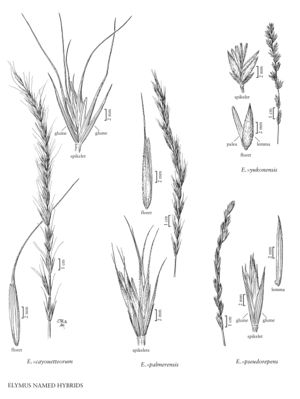Elymus ×cayouetteorum
Plants probably cespitose, not rhizomatous. Culms to 1 m tall, about 4 mm thick. Leaves not basally concentrated; sheaths smooth; ligules about 0.5 mm, glabrous; blades 20-30 cm long, about 10 mm wide, both surfaces scabrous. Spikes about 25 cm, lower nodes with 1 spikelet, most middle to upper nodes with 2; internodes about 18 mm. Spikelets about 40 mm including the awns, about 20 mm excluding the awns, appressed, with 5-8 florets. Glumes 12-15 mm, not or scarcely indurate, mostly smooth, veins scabrous, awns 3-5 mm; lemmas about 14 mm, glabrous, awns 18-22 mm, not to moderately divergent; anthers 1.8-2 mm, indehiscent.
Discussion
Elymus ×cayouetteorum consists of hybrids between E. trachycaulus (p. 321) and E. canadensis (p. 303). The above description is based on the type specimen, which was collected on the Ilets Jeremie, Quebec. It is not known how widespread such hybrids are.
Elymus ×cayouetteorum is an Elymus named hybrid
Elymus is notorious for its ability to hybridize. Most of its interspecific hybrids are partially fertile, permitting introgression between the parents. The descriptions provided below are restricted to the named interspecific hybrids. They should be treated with caution and some skepticism; some are based solely on the type specimen, because little other reliably identified material was available. Moreover, as the descriptions of the non-hybrid species indicate, many other interspecific hybrids exist.
The parentage of all hybrids is best determined in the field. Perennial hybrids, such as those in Elymus, can persist in an area after one or both parents have died out, but the simplest assumption is that both are present. Interspecific hybrids of Elymus that have disarticulating rachises presumably have E. elymoides or E. multisetus as one of their parents.
Selected References
None.
